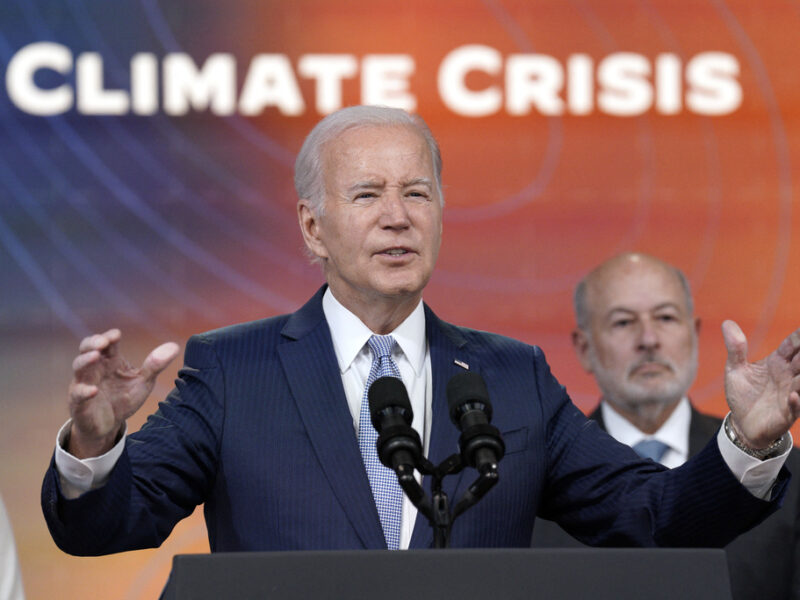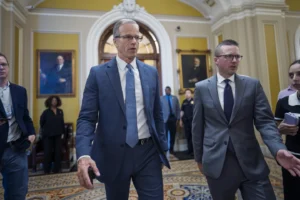Biden Takes Steps to Address Extreme Heat Amid ‘Existential Threat’ of Changing Climate
Wyoming’s congressional delegation opposes climate mitigation measures
- Published In: Politics
- Last Updated: Jul 28, 2023

President Joe Biden on Thursday announced a series of new measures to address extreme heat impacting millions of Americans throughout the nation. (Photo by Yuri Gripas/Abaca/Sipa USA via AP Images)
By Jacob Gardenswartz
Special to the Wyoming Truth
WASHINGTON — President Joe Biden on Thursday announced new steps his administration is taking to combat extreme heat, calling out the “existential threat” of climate change as over 80 million Americans were impacted by heat-related weather alerts this week.
“There will be more,” Biden predicted of such extreme heat events. “I don’t think anybody can deny the impact of climate change anymore.”
The president’s remarks came as the temperature in the nation’s capital surpassed 90 degrees fahrenheit, with the heat index heading well into the triple digits. Throughout the country, meanwhile, heat is posing significant dangers to Americans: doctors in Arizona are facing a spike in patients presenting with severe burns from falling on the ground, and a growing number of heat-related deaths have been reported throughout the West in recent days.
“The number one weather-related killer is heat,” noted Biden, flanked on stage by several of his top climate advisors. “Even those places that are used to extreme heat have never seen it as hot as it is now for as long as it’s been.”
In response, Biden said he directed the acting Secretary of Labor to issue the first-ever Hazard Alert for heat, giving information to employers about their legal requirements to provide workers with safe working conditions. The Occupational Safety and Health Administration (OSHA) will also step up enforcement and investigations to ensure employers were complying with the requirements, Biden said, particularly in industries most impacted by heat like agriculture and construction.
Additionally, the president announced a $152 million investment from the Department of the Interior to expand water storage measures in California, Washington and Colorado, and a $7 million investment from the National Oceanic and Atmospheric Administration (NOAA) to fund new and better weather forecasting systems.

Despite the severe weather, Biden sought to exude a sense of hope: “None of this is inevitable,” he argued, pointing to his administration’s many actions on climate.
Climate mitigation efforts impact key Wyoming industries
Representing one of the most conservative states in the country, Wyoming’s political leaders have by and large resisted all of the president’s significant actions taken to mitigate climate change.
As environmentalists continue to push for Biden to issue a national emergency declaration for climate change, opening up additional funding and executive powers to curb pollution, Sen. Cynthia Lummis (R-Wyo.) has signed onto legislation which would prevent him from doing just that. Rep. Harriet Hageman (R-Wyo.), meanwhile, recently co-sponsored a bill to defund the office of the Presidential Envoy on Climate Change. And Sen. John Barrasso (R-Wyo.) has frequently spoken out against Biden’s climate policies, arguing they only push development overseas.
Indeed, much of the Wyoming delegations’ criticisms of Biden’s policies have centered on allegations that they stifle domestic energy production — particularly of coal, oil and gas, resources central to the state’s economy. The lawmakers claim slowing production will only drive up consumers’ costs, arguing instead for more lax policies that promote energy development.
Yet failure to respond to changing climate conditions is also increasingly impacting pocketbooks in Wyoming and around the country. Earlier this year, the local utility outlet Rocky Mountain Power proposed a $50.3 million rate increase to account for higher prices resulting from extreme weather events and drought.
“Sharply higher prices in the wholesale power market during the severe summer weather of 2022 are responsible for nearly half of Wyoming’s share of increased power costs,” Jack Painter, a RMP official, said in an April statement. “Natural gas prices continued to be affected by weather events and supply issues. In December 2022 a historic winter cyclone impacted much of the country, prompting increased customer demand and leading to higher prices in both wholesale power and natural gas markets.
Such weather events are only expected to get worse. This year, Casper recorded the largest snowstorm in its history, though experts worry extreme storms could become the new normal.
The president, for his part, is not backing down from the fight. Speaking to his administration’s many climate mitigation efforts, he promised no amount of GOP pushback would prevent him from working to address rising temperatures.
“MAGA extremist Congress are trying to undo all this progress,” he alleged. “We’re not going to let that happen.”













